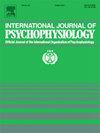题目主题对隐性信息测验差异反应的影响:知识语境与非知识语境的比较。
IF 2.6
3区 心理学
Q3 NEUROSCIENCES
引用次数: 0
摘要
基于自主的隐藏信息测试(CIT)侧重于对犯罪相关项目的差异反应,该项目仅对知识渊博的人有意义。本研究考察了关于定义知识和非知识背景的问题主题的测试前指示是否调节了对相关项目的差异反应的大小。在模拟偷窃任务中,参与者(36名男性,46名女性)被要求从两个可能的地点之一偷一件东西。在随后的CIT中,在两种不同的情境条件下呈现一组相同的物品,参与者被问及在两个地点分别偷了什么。参与者模仿偷窃的地点被定义为“相关的、有知识的”环境,而他们什么都不做的另一个地点被定义为“不相关的、没有知识的”环境。测试前的指示指定了环境,参与者被问及他们在每个环境中偷了什么。在CIT过程中,记录皮肤电导反应、心率和呼吸运动。结果表明,在相关条件和不相关条件下,对被盗物品的差异反应都存在,但在后一种情况下,差异反应的幅度较小。从应用的角度来看,前人对类似犯罪的经验可能会导致假阳性,但也应注意本实验的学习-测试间隔较短。我们的发现表明,CIT中的上下文指定指令是一个调制器,而不是相关项目重要性的唯一决定因素。本文章由计算机程序翻译,如有差异,请以英文原文为准。
Effect of a question theme on differential responding in the Concealed Information Test: Comparison of knowledgeable versus unknowledgeable contexts
The autonomic-based Concealed Information Test (CIT) focuses on differential responses to a crime-relevant item that is significant only for knowledgeable persons. This study examined whether pre-test instructions on question themes defining knowledgeable and unknowledgeable contexts modulate the magnitude of differential responses to the relevant item. The participants (36 men 46 women) were instructed to steal one item from one of two possible locations in a mock theft task. In the subsequent CIT, an identical set of items was presented under two different contextual conditions, and participants were asked what was stolen from each of the two locations. The location in which participants enacted the mock theft was defined as the “relevant, knowledgeable” context, whereas the other location where they did nothing was the “irrelevant, unknowledgeable” context. The context was specified by pre-test instructions, and the participants were asked what they had stolen in each context. During the CIT, skin conductance response, heart rate, and respiratory movement were recorded. The results indicated that differential responses to the stolen item occurred both in the relevant and the irrelevant conditions but tended to be smaller in magnitude in the latter. From an applied perspective, it was suggested that prior experience of similar crimes may lead to a false positive but the short study–test interval in this experiment should also be noted. Our finding implies that the context-specifying instructions in the CIT were a modulator rather than the sole determinant of the significance of the relevant item.
求助全文
通过发布文献求助,成功后即可免费获取论文全文。
去求助
来源期刊
CiteScore
5.40
自引率
10.00%
发文量
177
审稿时长
3-8 weeks
期刊介绍:
The International Journal of Psychophysiology is the official journal of the International Organization of Psychophysiology, and provides a respected forum for the publication of high quality original contributions on all aspects of psychophysiology. The journal is interdisciplinary and aims to integrate the neurosciences and behavioral sciences. Empirical, theoretical, and review articles are encouraged in the following areas:
• Cerebral psychophysiology: including functional brain mapping and neuroimaging with Event-Related Potentials (ERPs), Positron Emission Tomography (PET), Functional Magnetic Resonance Imaging (fMRI) and Electroencephalographic studies.
• Autonomic functions: including bilateral electrodermal activity, pupillometry and blood volume changes.
• Cardiovascular Psychophysiology:including studies of blood pressure, cardiac functioning and respiration.
• Somatic psychophysiology: including muscle activity, eye movements and eye blinks.

 求助内容:
求助内容: 应助结果提醒方式:
应助结果提醒方式:


